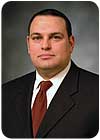
The Participants
Tom Fishback, Ph.D., Technical Director, Fomo Products Inc.Norm Kanar, Americas Area Market Manager, Pressure Sensitive Solutions, Dow Corning Pressure Sensitive Industry
David LeGrand, Director, Technology Platforms and Business Development, Henkel Corp.
Lex Reynolds, President, The Reynolds Co. Greenville, SC

Tom Fishback, Ph.D.
What are your predictions for the adhesives and sealants industry in 2007 and beyond?
Tom Fishback:We expect to see continued strong growth for sealants used in construction, especially where the sealant is part of an energy savings system, e.g., caulk and seal building envelope packages for residential and commercial buildings. Regarding adhesives, residential and commercial construction practices are evolving as leading builders substitute high-strength adhesives for mechanical fastening systems (nails, screws, etc.). For example, the devastating hurricane seasons of 2004 and 2005 in the Gulf Coast region showed that roofing tiles bonded to roofs using polyurethane foam adhesives remained intact during these events, whereas tiles that were fastened mechanically became dangerous projectiles.Norm Kanar:Silicone pressure-sensitive adhesives (PSAs) will exhibit healthy growth, fuelled in part by their increasing use in electronic applications.

Much of the new Boeing 787 is bonded with adhesives, including the outside covering (or nacelle) of the jet engine, the wing flaps, ailerons, interior luggage spaces, bathrooms and floors.
As people demand lighter, more durable consumer goods, Henkel is responding to applications that did not exist even five years ago. In commercial appliance manufacturing, adhesives and sealants are replacing welds and solder. Adhesives not only join the materials together, but deliver sound-dampening benefits, lighten the assembly, and enhance aesthetics.
We also see an increased focus on environmental requirements. As a global company, we are experiencing this demand on a regional basis. For example, it is presently Europe’s goal to convert entirely to environmentally friendly products without hazardous labels. Our customers in Europe are demanding a product lifecycle plan that slowly removes restricted or semi-restricted raw materials from adhesives and sealants. This is a subtle shift from demanding recyclable products to having the whole value chain provide environmental benefits.
Lex Reynolds:I see flat growth for the industry as a whole in 2007, primarily because of the slowdown in Housing and Automotive, particularly here in the U.S. Since most of our business is concentrated here, I do not look outside the U.S.

Norm Kanar
Where do you see the greatest opportunities for growth in the adhesives markets? Which chemistries are increasing in demand?
Fishback:High-strength adhesives will be in greater demand, especially those that can be used to bond a variety of construction materials such as wood, brick, polystyrene or polyisocyanurate insulation panels, concrete, and steel. Hurricane damage sustained during the past few years has led to new construction techniques that hold up better in severe weather incidents by providing greater structural integrity than traditional mechanical fastening techniques. Polyurethanes and epoxies will continue to be the predominant chemistries in high-strength construction applications.Kanar:In general, the use of silicone PSAs for electronics and electrical applications is growing.
LeGrand:The greatest opportunities are for materials that can satisfy more than one customer need; for example, silicones that provide extremely high heat resistance and fast fixturing time. In the past, using a silicone with high heat stability meant waiting hours for it to cure. New materials cure within minutes, increasing the efficiency of fully automated production lines by reducing production time and costs.
Relative to epoxies and acrylics, adhesion to engineered plastics is a key to growth. While plastics have been used for years in automotive applications, we are now seeing their use increase in appliances, alternative energy devices and consumer goods. One challenge is to bond an unprepared surface and deliver a highly durable joint. New adhesive products are doing just this, with fixturing speeds comparable to instant adhesives.
In the aerospace world, composite aircraft manufacturers are demanding resin systems that tolerate a long manufacturing process and still have high strength. For the past 25 years, toughened epoxy systems have been the standard, but their substantial limitations have driven the industry to look to alternative chemistries. Resin systems that are room-temperature stable and only cure under specific conditions are now being evaluated by the major aircraft manufacturers. We believe that in 10 years these Henkel systems will be prevalent in the industry.
Reynolds:I see hot melts continuing to displace waterborne and solvent chemistries, especially here in the U.S. where environmental issues are becoming increasingly important. In developing markets, where the environmental issues are not as important yet, I would expect demand for all kinds of products to be high. Growth opportunity, as always, will come in markets where new technology can be introduced.

David LeGrand
Do you see an increase or continuation in offshoring for the production of adhesives and sealants?
Fishback:No, the increasing technical service requirements for the North American market - coupled with ever-changing fastening practices in markets like construction - render offshoring a less desirable option than in the past.Kanar:New PSA production facilities have been added, mostly in China. Because market growth for silicone pressure-sensitive adhesives has been in the double digits for the past several years, capacity investments in Asia were to be expected.
LeGrand:The trend in the adhesives and sealants industry is that global formulations and technologies are being supplied on a regional basis. As most adhesives and sealants have a defined shipping life, shelf life, or hazard information, it’s better to produce, market and sell on a regional basis. Henkel is well positioned to fulfill this market need from adhesives and sealants manufacturing sites all over the world. Our global business teams interface on a strategic and product-development level so that products can be tailored regionally to specific applications needs.
Reynolds:I think that really depends upon the raw material stream. Since most of our cost is in raw materials, and not so much labor, I think the country/countries that will see the best opportunity for growth are those that can 1.) secure good streams of supply, and 2.) secure raw materials at the best price level. Both of these criteria are extremely important in our industry these days.

Lex Reynolds
How are raw material/feedstock price increases affecting product development and your bottom line? Will this activity continue through 2007?
Fishback:Raw material prices were somewhat stable in the last half of 2006, giving the industry a much-needed break from the supply disruptions and spiraling prices experienced by all in 2005. Moving forward, the new benchmark for the price of raw materials is higher than ever before, and, given the volatility associated with the global petroleum market, these new pricing tiers will probably remain in effect permanently. This must be factored into the business plan of new products when they are developed.Kanar:Rising costs of organic solvents, silicon metal, methanol, fluorochemicals and energy hit silicone PSAs especially hard in 2006. At Dow Corning, we rely on a “Solutions” business model in which we work with our customers on improvements that will offset - and in some cases reduce - our customers’ total cost.
LeGrand:2006 saw a large increase in raw material pricing. Most people expected to see increases due to petroleum, but we experienced unexpected increases of 20% or greater in other areas. For example, metals used in surface treatments, paper and cardboard used in packaging, and resins used to modify products.
One of the greatest contributors to these types of price increases is a rising demand for raw materials, which creates shortages. You can read about the economic expansion of China almost every day. Other growth markets are less documented, but also have a major impact. India is experiencing healthy growth, while the traditional users - Europe and Japan - have had strong economies, too. Supply and demand issues now need to be considered when determining sources in raw material costs.
Henkel is predicting that the increases borne by oil will stabilize at a higher level than those in early 2006, but not at the peak levels seen in the third quarter. Our commercial teams have focused considerable effort on developing long-term contracts that create supplier relationships and cost-reduction exercises to stabilize our raw material costs. It is a global effort by both our commercial teams and operational teams to implement cost of goods programs so our customers do not have to bear these increases alone.
Reynolds:I dare say there are few in our industry who have not been negatively impacted by the run-up in raw material prices. Everyone has been affected to some degree, and the industry’s failure to keep pace with these increases has impacted everyone. I believe this has been one of the great “failings” of our industry in the past couple of years - a lack of discipline within the industry to respond in a positive manner to rising raw material prices. From my personal perspective, I put the lion’s share of the blame with some of the larger players who simply drag their feet when it comes to responding to what is happening around us. Not to be outdone, I also know that there are some smaller players in the industry who still sell on price. Everyone knows who they are, except for the guilty parties, unfortunately. It is a sad state of affairs, and one that must change for the health of us all.
What happens going forward is anyone’s guess. My feeling is that there has been some significant “piling on” by suppliers to our industry over the last year or so, and I do not see any justification for further price hikes. Having said that, just like gasoline, I think the days of “cheap” raw materials are a thing of the past. There could be some moderation, but don’t expect wholesale price decreases.

What other challenges does your company currently face? What is being done to address these issues?
Fishback:With energy issues at the forefront, and taking into account the accelerating evolution of new construction practices designed to reduce energy consumption, managing the double-digit growth of our company has been - and remains - one of our biggest challenges.Kanar:At Dow Corning, innovations - including a solventless silicone PSA - are meeting our customers’ needs to reduce solvent handling. Plus, our platinum-curing PSAs are expanding the limits of performance.
LeGrand:Sustainability is a global challenge and a key focus for Henkel. We are dedicated to sustainability and corporate social responsibility, and we assume this responsibility wherever we operate. We contribute to society through our brands and technologies, while always striving to harmonize economic, ecological, and social objectives.
The challenges we face are global, but priorities and perspectives vary considerably from region to region. Viable solutions for the future can only be developed through ongoing dialogue with the social groups in the communities where we operate.
We also maintain a dialogue with external sustainability experts. What we learn from them helps us respond to specific local and regional needs.
On January 24, 2007, Henkel was proud to again be listed under the “Global 100: Most Sustainable Corporations of the World” by Innovest Strategic Value Advisors, based in Richmond Hill, Canada.
Reynolds:First, we need to improve our bottom line by raising prices and/or walking away from unprofitable business. When our customers don’t want to allow us the chance to make money, this makes the decision much easier. Quite honestly, we are at that stage, as I am sure many are. Unfortunately, there will be some companies who jump at the chance to pick up unprofitable business from others because they are blinded by the thoughts of volume. I am convinced that there are many in our industry who simply do not know how to calculate all their true (total) costs.
Secondly, we need to secure supply lines. There are still some tight supply situations, and I believe there will be some who may be cut off at some point. For us, treating our suppliers as we would expect to be treated is the key, particularly in times like now. Our reputation and integrity with our suppliers is important to us, and I think it has saved us during the last couple of years.
Lastly, we need to find new markets and new technologies to replace old, costly technologies through R&D efforts.